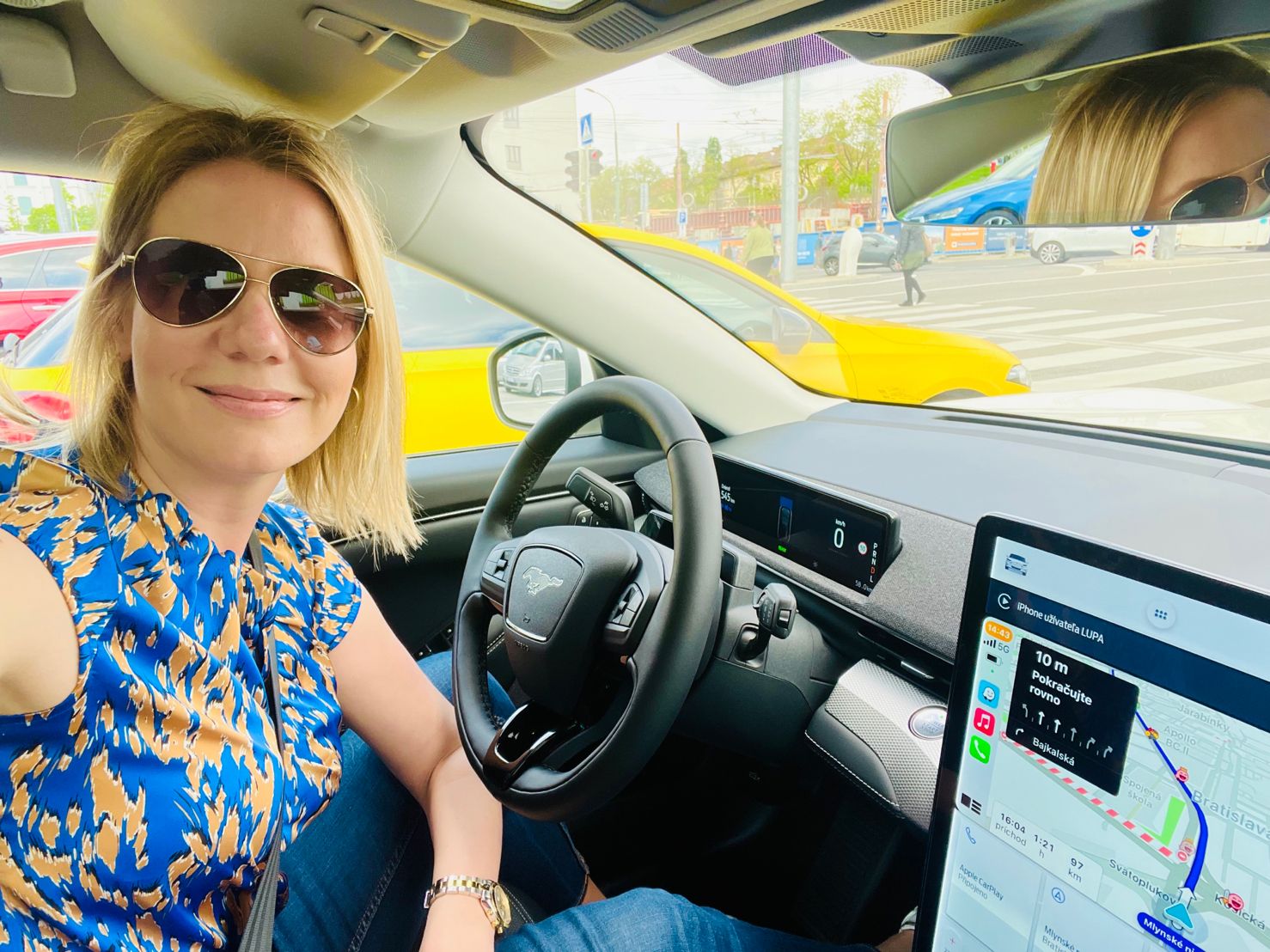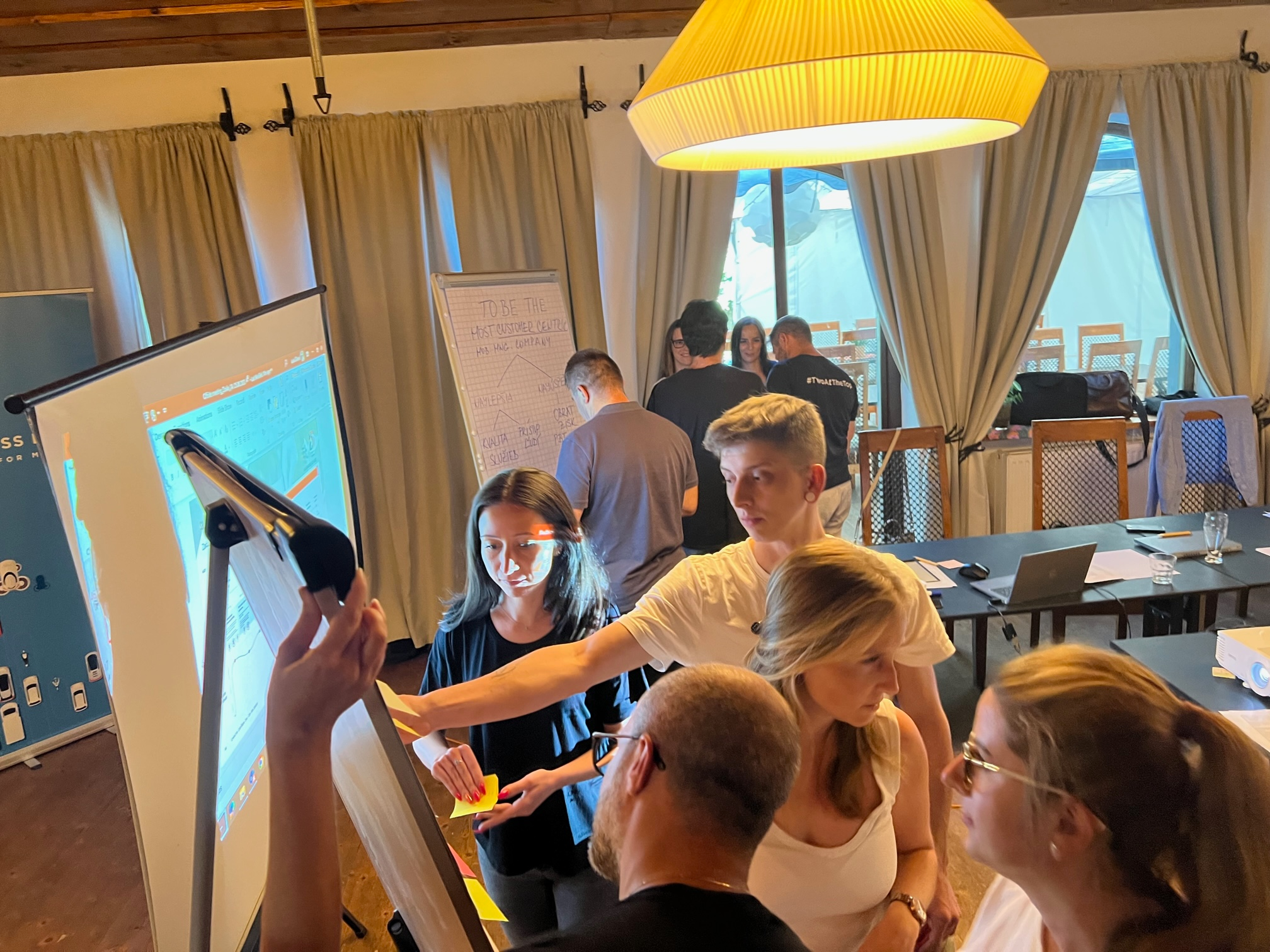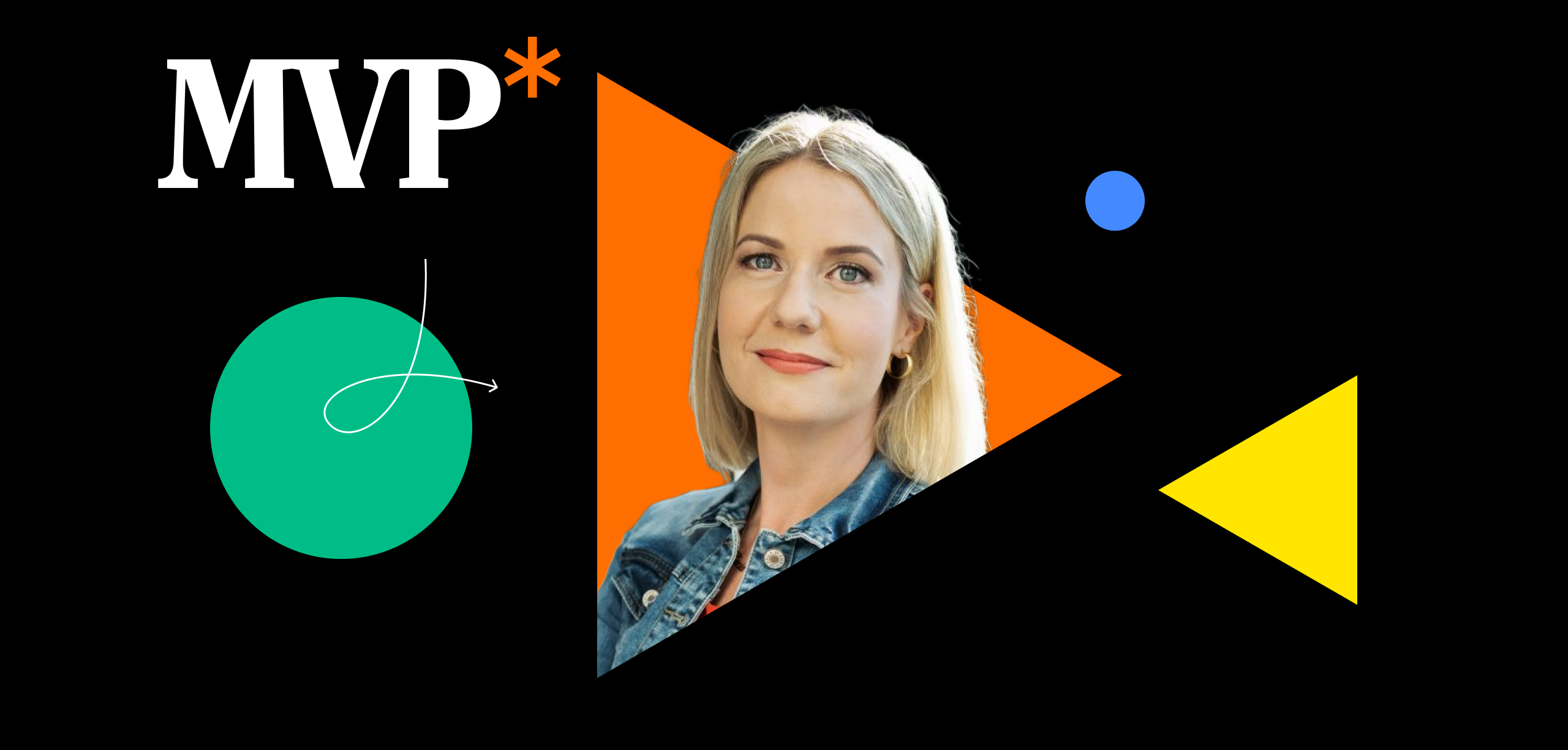In this podcast, we often talk about how to transform an organization to prioritize the customer. However, we rarely have representatives from small to medium-sized companies. In our recent survey on the state of CX in Slovakia, it was confirmed that the size of the company doesn't matter. Everyone can be successful.
In the 20th episode of the Minimum Viable Podcast, Michal Blažej discusses building Customer Experience in small organizations with Lucia Čišková, Managing Director of Business Lease Slovakia.
Minimum Viable Podcast is brought to you by the CX design studio Lighting Beetle*. It's usually recorded in the Slovak language, however, you can read an English transcription of this episode below. For more content in English, including case studies and handouts, visit our Journal.
Are you interested in the level of Customer Experience of your organization? Find out in few seconds by answering these 6 questions.
What does Business Lease do?
Business Lease has been providing services for corporate mobility in Slovakia for 25 years. For the past five years, we've also been dealing with mobility for individuals, which includes operational leasing services. Besides that, we offer additional services like short-term rentals under the Biznis Rent brand. We also manage vehicle fleets for clients who don't have their entire fleet under operational leasing but want to use operational leasing services. Additionally, we've expanded into selling used vehicles after operational leasing, which we market under the Cars & Care brand.
How does Business Lease differ from the competition?
We keep the customer at the center of attention. Our vision is to "be the most customer-oriented company in the mobility management segment."
In simple terms, we want to be among the best and most successful companies in Slovakia. To break it down, being the best means being a hero in service quality and then in the approach of our people.
You Are a multinational company. Is the corporate vision defined for the entire group?
Yes. I'm very pleased that this vision came from the top and wasn't just defined locally in Slovakia. In 2018/2019, there was a beautiful alignment and what I wanted to implement in Slovakia was supported by our leadership. Business Lease's main value is care. Operational leasing services are similar everywhere. We need a key differentiator that will propel us forward and we achieve that by our approach to customers. My vision was driven by the desire to make a big leap in finances and satisfaction among both employees and customers. I wanted to double the results, so I started looking for a way to achieve this goal.

Companies often ask themselves how to differentiate, and Customer Experience is one of the possibilities. However, you combined CX with business results, which usually happens later in a company's development. You managed to do it in one step. You mentioned the results. What have you achieved?
In five years, we've managed to increase our fleet by 38%, our profitability from 1.7 to 5.2 million, our NPS score from 41 points to 64, handling complaints decreased from 13 days to 3.7 days, and we moved our Customer Satisfaction (CSAT) score from 70 to 86 points.
Regarding the employees, we've rapidly decreased previously high fluctuation, and nowadays we keep it under 5%, which means a stable and content team. In terms of the willingness of our employees to recommend Business Lease as an employer, we've moved from 67 to 76.5.
It's interesting that customer experience is often more about employee satisfaction. You mentioned several internal KPIs and then financial indicators, which is challenging to connect. How do they influence each other?
It's simple. Increasing the quality of services and the approach of employees causes higher customer satisfaction and higher sales. It turns out that 30% of new customers come based on word of mouth and the good name of Business Lease. This allows us to cut marketing expenses.
So the answer is loyalty and satisfaction of existing customers.
With current customers, we measure the so-called repeat rate. This is our ability to renew the vehicle fleet for a given client. We've increased this from 48% to 62%. Of course, we also have customer churn. We measure churn rate on a monthly basis because we know that acquiring a new customer is much more expensive than retaining an existing one and we want to keep this under control.
I assume that you monitor financial indicators every day. How often do you check the other data?
In 2018 we wanted to get the company results under control and we found out we weren't achieving what we wanted. So, we introduced these so-called mid-month meetings where the entire middle management sits and they are trying to find out where we're falling behind while still having two more weeks until the end of the month to deliver the expected results
Regarding the customer experience, it's measured in various ways. It can't always be done on a monthly, or more frequent basis, but we collect feedback continuously.
Likewise, Employee Net Promoter Score (eNPS) probably can't be measured on a weekly basis, right?
It's measured twice a year.
What was the journey to implementing a better Customer Experience like?
At the very beginning, we needed to stabilize the team. To have clarity about the vision, mission, values, and culture. We wouldn't have achieved these results in life if we had chaos at home. It took six to eight months of intensive work with the team.
We conducted a major employee survey, based on which we began making changes on a monthly basis. Also moving people to the right positions was also one of the problems. Then we defined the culture we wanted to have at Business Lease so that everyone feels comfortable here.
Imagine about 19-20 bullet points. Openness, open communication, active listening, feedback, and so on.. What was written had to be understood as well. This took from 6 to 8 months.
"We would have never achieved the results if we had chaos at home."
Then we could move on to the second phase. With Jan Urig, we had a two-day workshop, and he asked us which company was close to our hearts. I mentioned e-obuv because I love that within 48 hours I can have any shoes delivered and I can immediately try them on.
We had "Care" as our differentiator, but we didn't know what that meant. How would Business Lease differentiate itself? Then we got acquainted with the customer journey. For me, it was very shocking to find out that our process diagram was vertical. We described everything using our terminology, from our perspective, it was all about "us, us, us." The customer wasn't mentioned at all.
Jan showed us the customer journey horizontally. Everything was defined from the customer's perspective, which was a big difference. The second point was starting to work on it. The third point was how we address problems in the company.
The problem was that four of us, wise heads, sat down, we understood what it was about, we defined it, we implemented it, and we found that the customer still wasn't satisfied. Design thinking is about empathy with the customer. So, we started with mapping customer journeys. We did this through personal interviews with our customers. We put in a lot of effort, and prepared our questions.
So, we have the customer journey of our client, our driver, our Cars & Care customer who buys a used car after operational leasing. We also don't forget about the employees. We have the employee's customer journey as well. It needs regular refreshes, so we update it every year or two based on the feedback we collect through qualitative or quantitative surveys.
Have you identified what your opportunities for improvement are? Or how did opportunities for improvement compare to the customer journey you designed with customers? How did you prioritize among those various initiatives?
You need to distinguish between initiatives for a "quick fix”, "mid-term", and "long-term". You can't do everything, although I have this characteristic of wanting to do everything at once. The customer journey helped us identify where we have room for improvement. It repeatedly showed us that we thought differently.
We thought that our customers really cared about the delivery of a new vehicle, that it was a crucial moment for them. The opposite is true. Of course, they are very excited, but it's not crucial for the customer at all. What's crucial is, for example, the duration they stay with us. They don't want full service only on the day of delivering the car; they want it throughout the entire period. They need to drive, and we need to take care of service, tire service, and continuously improve our services.
Next is the termination of operational leasing. Is that also a source of concern? How does operational leasing end? Customers told us that returning their car is a very emotionally challenging experience for them too. We've marked this as "Red Point."
CX is about emotions. What emotional experience do the customers have at every point of contact with Business Lease. And the question arises here, how to deal with it?
We started doing projects - Rapid Deployment Units (SWAT). This way, we started transforming Red Points into Green Points with very nice results. To this day, we've completed 15 of such projects.
What does a SWAT project look like, and how does it differ from the others?
For the implementation of CX, onboarding all employees is crucial. Our employees themselves defined they want to put the customer first. We knew about Red Points and started addressing them through SWAT projects. The project consists of four to six people. It takes about six to 8 weeks and has a clearly defined goal. People volunteered for these projects. All areas of the company are represented in the project to cover the entire customer journey. Marketing and communication are also essential. I would highlight two projects that were successful.
Imagine that you have 7,500 cars, that's 7,500 drivers who use your services across Slovakia. We provide services through our partner service network, which is quite extensive. It's crucial that the Customer Experience is what the customer expects and that services work the same way everywhere. Therefore, it was essential to do two things.
"We thought that our customers really cared about the delivery of a new vehicle, that it was a crucial moment for them. However, the opposite is true."
First, unify the quality of services. With us, you get pick-up service, you get a replacement vehicle when yours stays in service for more than 24 hours. When the repair is over 150 euros, we wash your car. We had parameters we needed to standardize across Slovakia.
It was a big challenge to change all the contracts, and it also took us some time. However, we succeeded. Then there was the question of how to get customers into the right services. That's when we implemented a call center line, which we had to teach our customers to call. Today, about 78% or even 80% of our customers call this line, which guides them to repair shops where we have a consistent level of quality.
This SWAT project took longer than eight weeks. What was the time limit you set there? What was the output of this project after eight weeks, for example?
We implemented a call center line and we communicated the information about it through our website, through various documents, we handed over the car with information about the call center, etc. Until then, customers went everywhere, and it happened that they didn't get a pick-up or replacement vehicle.
After every service visit, we also measure the experience. In satisfaction surveys, we saw a clear jump. Previously, we scored around 78 points, and now it's over 90, but we still want to go further.
SWAT projects are intended to bring dynamics to large companies' overloaded processes. The significant value for the company is that it's not burdened by a two-year planned project.
The great advantage of Business Lease is that we have fifty employees, and we can implement changes quickly. We also have a clear vision from our group. The Business Lease Group operates in five countries, so we can implement changes as a group.
We don't have two-year projects here, except perhaps for digital transformation. The vision comes from above, but we have a lot of freedom in how we provide our services. We know our market, we know our customers, so we have a lot of flexibility in this regard.
I would like to go into more detail about the transformation within the organization. How did you manage to get employees on board? Was it part of your corporate strategy?
We introduced a different way of handling complaints through "customer feedback coffee sessions." Employees said they wanted to address customers and they made them their priority. They saw that satisfaction was declining. They named it themselves, and we created a tool.
Twice a week, people from various areas have 15 to 20-minute meetings where they discuss problems and immediately look for solutions.

Creating rituals while giving people the freedom to change things is crucial. Indeed, influencing the Customer Experience effectively cannot happen without a transformation of the culture, which was your first step.
Emphasizing the vision is also important, repeating it constantly, and returning to it. It wouldn't work without goals either. Suddenly, our goals weren't just financial results, the fleet, and profit. Employee satisfaction and customer satisfaction had the same weight. The whole team had the same goals, which were equally important to everyone.
I'll ask about the education of other people, not just management. Have they gone through any training or education there?
Know-how regarding customer experience is very scarce in Slovakia. We have Palo Mikolaj, who is certified. So, he brought knowledge, which I see as an important element in the company's development and growth. I started studying as well, but it's going slowly because I'm always so interested that I want to implement it into the company immediately.
I really appreciate companies that are in Slovakia and focus on CX because they helped us with customer journeys and interviews. We didn't have this know-how. We didn't train people; we simply involved them in activities.
"Knowledge about customer experience in Slovakia is very poor."
When we conducted qualitative interviews with our customers, we didn't do it by hiring a company to do the interviews and provide us with results. We had our employees conduct the interviews with external experts as observers and supervisors. It's best to learn by doing.
CX is about emotions, and those emotions come from our employees. To create a bond with the customer, we need to define six emotional drivers and use them. For example, when a customer says they trust us, or that we fix something for them, or that we keep promises, we try to motivate with it among various positions in the company so that employees know what they can influence and enhance.
Training and knowledge of the methodology are good, but the design of the customer experience is largely about common sense. You've tackled it very well by involving employees directly into real projects. Finally, I have two more questions. What are your challenges? What are your personal challenges?
We would like to expand our service portfolio. We want to introduce a fixed operational leasing product, including all possible costs like inflation fluctuations, interest rates, or the possibility that you might damage the car at the end. We want to launch it in January. This whole idea came from customer feedback.
The second service is called "Go Better," where we adapt feedback from customers. We toyed with the idea of how customers could become carbon-neutral. This Go Better program will enable them to do so. It's about first measuring their current carbon footprint, providing an analysis, followed by driver training for eco-friendly driving.
We have a digital tool for this that we'll implement in cars, which can measure your driving style and provide feedback. Finally, we have a clear process for how we can reduce emissions. In the long term, it's about service quality, and the approach of our people. I constantly keep this in mind and want to keep working on it. So, implementing these emotional drivers into the company and assigning them to specific roles is essential to me. But what I haven't mentioned yet is that on the 7th of August, we implemented a completely new digital system, an ERP system. We digitalized everything.
It's a significant step for us because it allows us to support future growth. With this system, we can easily absorb thousands of more cars. That's important, and that's where we're heading because achieving that five million revenue in one year is one thing, but when it happens for five consecutive years or even more, I'll be satisfied. That's my long-term goal, to truly have those five million consistently.
I'm curious about your design challenge in life that you'd like to solve.
The automation of the entire customer journey in terms of processes from the customer's perspective. So, today, there's a lot relying on the human factor. From our services to handling insurance claims, and more. On the other hand, only the human factor can provide emotion, however, I see a massive opportunity for digitalization and automation in that process. I wish it all went smoothly and automatically, systemically, from start to finish. In the end, the customer will say that they've never experienced anything better, not just because the process went smoothly and systematically, but because it frees our hands for even more humanity. Personalized service. When we manage to harmonize this, customers will be extremely satisfied and will say they've never experienced anything better than Business Lease.
So, you're from the group that sees automation positively because it will give you more time for relationships and interactions. I don't know if you have data from your segment. I recently read agency data from agencies that were able to implement automation, mainly using Artificial Intelligence. In this case, their gross margins increased by 70%. So, automation could also help you achieve your long-term goal.
Listen to the whole interview with Lucia Čišková in Slovak:
Minimum Viable Podcast is brought to you every two months by the design studio Lighting Beetle*, which focuses on creating an exceptional customer experience.
Design is all around us. Minimum Viable Podcast explores design with a small “d” – the one that looks for solutions to people's problems. In it, together with our guests, we address topics that are related to design, but we normally do not associate with it. Thanks to the Zeldeo production studio and our production manager Mojmír Procházka for the cooperation.
We are looking forward to every listen, follow, share, and suggestion for improvement. You can send us your tips for interesting personalities with whom we can talk about design to podcast@lbstudio.sk.
Enjoy!



